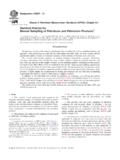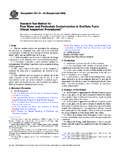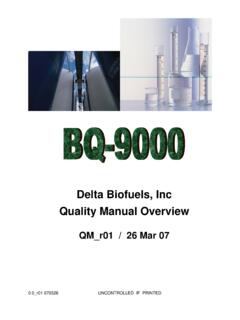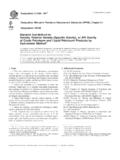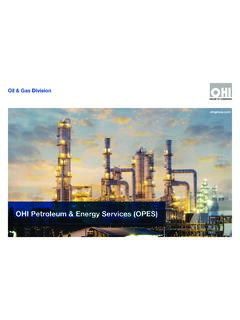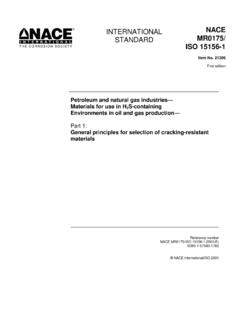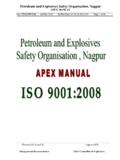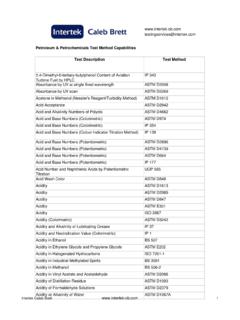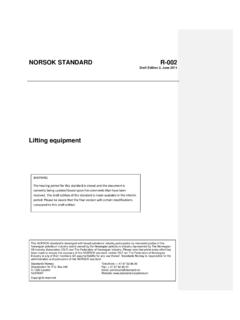Transcription of Standard Test Method for Density, Relative Density, or API ...
1 Designation: D1298 12bManual of petroleum Measurement Standards (MPMS), Chapter Test Method forDensity, Relative Density, or API Gravity of Crude Petroleumand Liquid petroleum Products by Hydrometer Method1 This Standard is issued under the fixed designation D1298; the number immediately following the designation indicates the year oforiginal adoption or, in the case of revision, the year of last revision. A number in parentheses indicates the year of last reapproval. Asuperscript epsilon ( ) indicates an editorial change since the last revision or Scope* This test Method covers the laboratory determinationusing a glass hydrometer in conjunction with a series ofcalculations, of the density, Relative density, or API gravity ofcrude petroleum , petroleum products, or mixtures of petroleumand nonpetroleum products normally handled as liquids, andhaving a Reid vapor pressure of kPa ( psi) orless.
2 Values are determined at existing temperatures andcorrected to 15 C or 60 F by means of a series of calculationsand international Standard The initial hydrometer readings obtained are uncor-rected hydrometer readings and not density are measured on a hydrometer at either the referencetemperature or at another convenient temperature, and readingsare corrected for the meniscus effect, the thermal glass expan-sion effect, alternate calibration temperature effects and to thereference temperature by means of the petroleum MeasurementTables; values obtained at other than the reference temperaturebeing hydrometer readings and not density Readings determined as density, Relative density, or APIgravity can be converted to equivalent values in the other unitsor alternate reference temperatures by means of Interconver-sion Procedures (APIMPMSC hapter ), or Adjunct toD1250 Guide for petroleum Measurement Tables (APIMPMSC hapter ), or both, or tables, as The initial hydrometer readings determined in the labo-ratory shall be recorded before performing any calculations required in Section10shall be applied to theinitial hydrometer reading with observations and results re-ported as required by Section11prior to use in a subsequentcalculation procedure (ticket calculation, meter factorcalculation, or base prover volume determination).
3 A1contains a procedure for verifying or certify-ing the equipment for this test The values stated in SI units are to be regarded asstandard. The values given in parentheses are provided forinformation Standard does not purport to address all of thesafety concerns, if any, associated with its use. It is theresponsibility of the user of this Standard to establish appro-priate safety and health practices and determine the applica-bility of regulatory limitations prior to Referenced Standards:2D1250 Guide for Use of the petroleum Measurement TablesD4057 Practice for Manual Sampling of petroleum andPetroleum ProductsD4177 Practice for Automatic Sampling of petroleum andPetroleum ProductsD5854 Practice for Mixing and Handling of Liquid Samplesof petroleum and petroleum ProductsE1 Specification for ASTM Liquid-in-Glass ThermometersE100 Specification for ASTM Standards:3 MPMSC hapter Sampling of petroleum andPetroleum Products (ASTM PracticeD4057)MPMSC hapter Sampling of petroleum andPetroleum Products (ASTM PracticeD4177)MPMSC hapter and Handling of Liquid Samplesof petroleum and petroleum Products (ASTM PracticeD5854)MPMSC hapter and Pressure Volume Cor-rection Factors for Generalized Crude Oils, Refined Prod-ucts and Lubricating Oils (Adjunct to ASTMD1250)1 This test Method is under the jurisdiction of ASTM CommitteeD02onPetroleum Products and Lubricants and the API Committee on PetroleumMeasurement, and is the direct responsibility of , thejoint ASTM-API Committee on Hydrocarbon Measurement for Custody Transfer(Joint ASTM-API).
4 Current edition approved June 1, 2012. Published October 2012. Originallyapproved in 1953. Last previous edition approved in 2012 as D1298 12a. referenced ASTM standards, visit the ASTM website, , orcontact ASTM Customer Service at ForAnnual Book of ASTMS tandardsvolume information, refer to the Standard s Document Summary page onthe ASTM as Manual of petroleum Measurement Standards. Available from theAmerican petroleum Institute (API), 1220 L St., NW, Washington, DC 20005.*A Summary of Changes section appears at the end of this standardCopyright ASTM International, 100 Barr Harbor Drive, PO Box C700, West Conshohocken, PA 19428-2959. United States1 Copyright by ASTM Int'l (all rights reserved); Wed Mar 27 15:28:11 EDT 2013 Downloaded/printed byCarlos Croatto (Kolmar Americas, Inc.) pursuant to License Agreement. No further reproductions Institute Standards:4IP 389 Determination of wax appearance temperature(WAT) of middle distillate fuels by differential thermalanalysis (DTA) or differential scanning calorimetry (DSC)IP Standard Methods Book,Appendix A, Specifications IPStandard Standards:5 ISO 649-1 Laboratory glassware Density hydrometers forgeneral purpose Part 1: Adjuncts:Adjunct toD1250 Guide for petroleum Measurement Tables(APIMPMSC hapter )63.
5 Of Terms Specific to This gravity, n a special function of Relative density(specific gravity) 60/60 F, represented by: density 60/60 F!# (1) No statement of reference temperatureis required, as 60 F is included in the point, n temperature at which a cloud of waxcrystals first appears in a liquid when it is cooled under , n the mass of liquid per unit volume at 15 Cand kPa with the Standard unit of measurement beingkilograms per cubic Other reference temperatures, such as20 C, may be used for some products or in some preferred units of measurement (for example, kg/L org/mL) are still in reading, n the point on the hydrometerscale at which the surface of the liquid cuts the In practice for transparent fluids thiscan be readily determined by aligning the surface of the liquidon both sides of the hydrometer and reading the Hydrometerscale where these surface readings cut the scale (HydrometerReading Observed).
6 For nontransparent fluids the point atwhich the liquid surface cuts the Hydrometer scale cannot bedetermined directly and requires a correction (Meniscus Cor-rection). The value represented by the point (Meniscus Read-ing) at which the liquid sample rises above the main surface ofthe liquid subtracted from the value represented by where themain surface of the liquid cuts the Hydrometer scale is theamount of the correction or Meniscus correction. This menis-cus correction is documented and then subtracted from thevalue represented by the Meniscus Reading to yield theHydrometer Reading corrected for the Meniscus (HydrometerReading Observed, Meniscus Corrected). values, n values observed at temperaturesother than the specified reference temperature. These values areonly hydrometer readings and not density, Relative density(specific gravity), or API gravity at that other point, n lowest temperature at which a testportion of crude petroleum or petroleum product will continueto flow when it is cooled under specified density (specific gravity), n the ratio of themass of a given volume of liquid at a specific temperature tothe mass of an equal volume of pure water at the same ordifferent temperature.
7 Both reference temperatures shall beexplicitly Common reference temperatures in-clude 60/60 F, 20/20 C, 20/4 C. The historic deprecated termspecific gravitymay still be appearance temperature (WAT), n temperatureat which waxy solids form when a crude petroleum orpetroleum product is cooled under specified Summary of Test The sample is brought to a specified temperature and atest portion is transferred to a hydrometer cylinder that hasbeen brought to approximately the same temperature. Theappropriate hydrometer and thermometer, also at a similartemperature, are lowered into the test portion and allowed tosettle. After temperature equilibrium has been reached, thehydrometer scale is read, and the temperature of the testportion is taken. The observed hydrometer reading is correctedfor the meniscus effect, the thermal glass expansion effect,alternate calibration temperature effects and then reduced to thereference temperature by means of the volume correctionfactors or tables as applicable by use of the appropriate AdjuncttoD1250 Guide for petroleum Measurement Tables (APIMPMSC hapter ) and observed temperature from If necessary, the hydrometer cylinder and its contentsare placed in a constant temperature bath to avoid excessivetemperature variation during the Significance and Accurate determination of the density, Relative density(specific gravity)
8 , or API gravity of petroleum and its productsis necessary for the conversion of measured volumes tovolumes or masses, or both, at the Standard reference tempera-tures of 15 C or 60 F during custody This procedure is most suitable for determining thedensity, Relative density (specific gravity), or API gravity oflow viscosity transparent liquids. This procedure can also beused for viscous liquids by allowing sufficient time for thehydrometer to reach temperature equilibrium, and for opaqueliquids by employing a suitable meniscus correction. Addition-ally for both transparent and opaque fluids the readings shall becorrected for the thermal glass expansion effect and alternatecalibration temperature effects before correcting to the refer-ence from Energy Institute, 61 New Cavendish St., London, W1M 8AR, from American National Standards Institute (ANSI), 25 W. 43rd St.,4th Floor, New York, NY from ASTM International Headquarters.
9 Order Adjunct Original adjunct produced in 12b2 Copyright by ASTM Int'l (all rights reserved); Wed Mar 27 15:28:11 EDT 2013 Downloaded/printed byCarlos Croatto (Kolmar Americas, Inc.) pursuant to License Agreement. No further reproductions When used in connection with bulk oil measurements,volume correction errors are minimized by observing thehydrometer reading at a temperature close to that of the bulk Density, Relative density, or API gravity is a factorgoverning the quality and pricing of crude , this property of petroleum is an uncertain indicationof its quality unless correlated with other Density is an important quality indicator for automotive,aviation and marine fuels, where it affects storage, handlingand ,of glass, graduated in units of Density, Relative density, or API gravity as required, conforming toSpecificationE100or ISO 649-1, and the requirements giveninTable The user should ascertain that the instruments used forthis procedure conform to the requirements set out above withrespect to materials, dimensions, and scale errors.
10 In caseswhere the instrument is provided with a calibration certificateissued by a recognized standardizing body, the instrument isclassed as certified and the appropriate corrections for themeniscus effect, the thermal glass expansion effect, and alter-native calibration temperature effects shall be applied to theobserved readings prior to corrections. Instruments that satisfythe requirements of this test Method , but are not provided witha recognized calibration certificate, are classed as ,having range, graduation intervals andmaximum permitted scale error shown inTable 2and conform-ing to SpecificationE1or IP Appendix Alternate measuring devices or systems may be used,provided that the total uncertainty of the calibrated system is nogreater than that specified The stated repeatability andreproducibility values are not applicable if alternate fluids areused in the liquid-in-glass Cylinder,clear glass, or plastic ( ).
